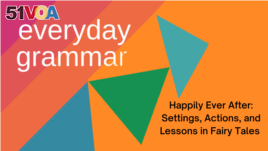09 February 2023
Recently, we discussed traditional stories called fairy tales. These stories are passed down through the generations.
We learned that these tales take place at an inexact time in the past: once upon a time or long ago. They include wonderful characters and magical elements like special numbers and talking animals!
But that was just the start of these special stories. In today's Everyday Grammar, we will consider how fairy tales end. We also will talk about the setting, the action of the story, and the life lessons a reader might learn.

Happily Ever After: Settings, Actions, and Lessons in Fairy Tales
Settings
The setting of a story answers questions about "where" it takes place. Since most fairy tales are very old stories, they take place in settings like forests, castles, villages, small countryside houses, or farms.
Readers need to create a picture of these places in their minds. Fairy tales use adjectives to describe the wonderous settings.
Let's look at a few examples:
In the fairy tale, Puss in Boots, the hero, is a cat (which wears boots) that enters the "stately castle" of an ogre. There, the cat tricks the giant creature into turning himself into a mouse which the cat immediately eats. In the castle, there are "spacious halls," which the cat will later walk through with the king.
The adjective "stately" means something that is impressive in appearance, behavior or size.
"Spacious" is another adjective meaning wide, open and with a lot of room or space. The use of special adjectives in fairy tales is meant to paint a picture in the mind that makes the story come to life.
In the Grimm Brothers' telling of Snow White, the opening setting helps describe something else ... Snow White, herself:
White snow was falling, and the cruel queen was sitting by a window surrounded by black material. She stuck her finger with her sewing needle, creating red drops of blood. The Queen asked for a child with these colors. Pale, or snow-white skin, black hair, and rosy, red cheeks and lips.
In this telling, the setting creates a magical picture of our main character even before she appears in the story.
Let's move onto "actions" in the fairy tales
Actions
A hero or heroine might meet other important characters, fight an evil villain, complete a magical task, or adventure, or do something three times. There are many possibilities!
The action of the story answers the question: "What is happening?" It describes the events or plot of the story. We can look at the verbs and adverbs in the fairy tale to see how the plot develops and where the conflict comes in.
Here is an example from The Snow Maiden:
"She grew very rapidly – not only daily but hourly – into a tall, beautiful, and graceful girl..."
We see that the writer uses "grew" as the verb and "rapidly," "daily," and "hourly" to intensify the reader's understanding of the Snow Maiden's growth.
After a time, spring comes and so does conflict. Because the weather is warm, the Snow Maiden is sad, and she does not want to play with her friends in the forest. After a while, she finally agrees, but something happens...
As the Snow Maiden "was jumping over the flames after her companions, she evaporated into a thin cloud..."
Here we see the phrasal verb "to jump over" in the past progressive form. And we see the verb "evaporate," which is a highly descriptive verb meaning "to disappear into nothing."
And this brings us to lessons and closings.
Lessons and closings
Not all fairy tales teach morals or lessons for our daily lives, but many do. Fables are such stories. They often use animals that behave like humans to teach lessons about life. These tales often end with a moral.
For example, in the Town Mouse and the Country Mouse, the country mouse visits his cousin, the town mouse. In the busy town, their fancy dinner is interrupted by two large dogs.
The moral of the story is: It is better to live in peace and quiet and have a simple life, than to live in fear surrounded by comfortable objects.
The final words in many fairy tales are well known. After the hero or heroine succeeds or there is a marriage, "they all lived happily ever after."
This phrase provides a summary to finish the story and leave readers with good thoughts. We often expect "happy endings" to many of our stories, not just fairy tales.
Although many fairy tales do end this way, others might not. For example, the Snow Maiden ends sadly for the old husband and wife who wanted a child. The Snow Maiden evaporates while jumping over a fire.
Final thoughts
Today, we talked about fairy tale endings, which do not always end "happily ever after." We answered the question of "where" when we talked about settings. We learned how adjectives can describe those places. We also considered the actions and plots of some fairy tales. By using verbs and adverbs, writers develop stories or create interesting conflict. And, we gave some thought to the morals or lessons of the tales, especially with fables.
Let's close with some homework. Do you remember the fairy tale you chose a few weeks ago? Answer the following questions: Where does the fairy tale take place? What verbs and adverbs are used to talk about the action or plot of the tale? Is there a moral or lesson? What is it?
After that, consider: How does the fairy tale end? Is there a "happily ever after" ending? Or is it sad?
Send your answers to learningenglish@voanews.com
Share your work in the comments below!
I'm Faith Pirlo. And I'm Caty Weaver.
Faith Pirlo wrote this lesson for VOA Learning English.
__
Words in This Story
character –n. a person in a story, book, movie or play
magical –adj. something with impossible powers
castle – n. a large building, usually with thick walls where people like kings and queens live
boots –n. (pl.) tall shoes that protect the lower part of the leg
ogre – n. a horrible giant monster in fairy tales
sewing needle – n. a thin piece of metal that is used with thread to make or repair cloth material such as clothes
pale – adj. light in color
task –n. a job or something that must be done
graceful –adj. moving in a smooth and attractive way
companion - n. a person or animal you spend time with or enjoy being with
evaporate –v. to go away suddenly, to disappear or vanish; v. to change from a liquid into a gas
lesson –n. something learned through experience or taught to affect future behavior
fancy –adj. not plain or ordinary, but costly or desirable
comfortable – adj. giving physical ease
phrase –n. two or more words that do not form a complete sentence but that express an idea











